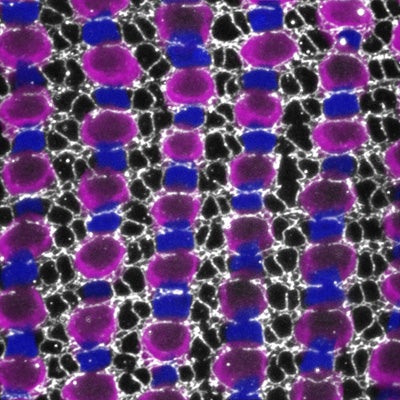 The overall objectives of current research efforts in the Raymond laboratory are to understand the molecular basis of cell-cell interactions that regulate retinal neurogenesis (the formation and regeneration of neurons) and neuronal specificity (the expression of differentiated cellular features), and to define and characterize the molecular profiles of retinal stem cells and retinal progenitor cells in the embryonic and adult zebrafish retina. We are characterizing the cellular and molecular properties of retinal stem cells and progenitors, and we are seeking to understand the regulatory mechanisms that control proliferation, determination, differentiation and patterning of retinal neurons, especially photoreceptors. Because of the strong evolutionary conservation of structure and function in the vertebrate retina, the cellular and molecular properties of the teleost fish retina are remarkably similar to those of the mammalian retina, and we believe that studying stem cells in the fish retina, which are able to effectively repair and regenerate the neural retina even in the adult, will help us to uncover fundamental and universal properties of neural stem cells in humans.
The overall objectives of current research efforts in the Raymond laboratory are to understand the molecular basis of cell-cell interactions that regulate retinal neurogenesis (the formation and regeneration of neurons) and neuronal specificity (the expression of differentiated cellular features), and to define and characterize the molecular profiles of retinal stem cells and retinal progenitor cells in the embryonic and adult zebrafish retina. We are characterizing the cellular and molecular properties of retinal stem cells and progenitors, and we are seeking to understand the regulatory mechanisms that control proliferation, determination, differentiation and patterning of retinal neurons, especially photoreceptors. Because of the strong evolutionary conservation of structure and function in the vertebrate retina, the cellular and molecular properties of the teleost fish retina are remarkably similar to those of the mammalian retina, and we believe that studying stem cells in the fish retina, which are able to effectively repair and regenerate the neural retina even in the adult, will help us to uncover fundamental and universal properties of neural stem cells in humans.
We use zebrafish as a model system, and we concentrate on a selected subset of molecular interactions that are likely to be involved in determination of cell fate in retinal stem cells and progenitor cells during development and retinal regeneration. These include extrinsic signaling molecules – such as the Notch and TGF-beta signaling pathways; modulators of cell adhesion and cell polarity – such as cadherins and the crumbs complex; and transcriptional regulators – especially the family of paired-like homeodomain proteins that have been implicated in the regionalization of brain territories, the control of proliferation, and the determination of specified progenitor cells and differentiated cell fates.
 We are also interested in understanding the cellular and molecular mechanisms of neuronal pattern formation, especially the formation of precise arrays of cone photoreceptors in the teleost fish retina. To uncover the biological mechanisms responsible for planar organization and cell fate determination, we have adopted an interdisciplinary approach including genetic tools, microscopic imaging, and computational analysis.
We are also interested in understanding the cellular and molecular mechanisms of neuronal pattern formation, especially the formation of precise arrays of cone photoreceptors in the teleost fish retina. To uncover the biological mechanisms responsible for planar organization and cell fate determination, we have adopted an interdisciplinary approach including genetic tools, microscopic imaging, and computational analysis.

